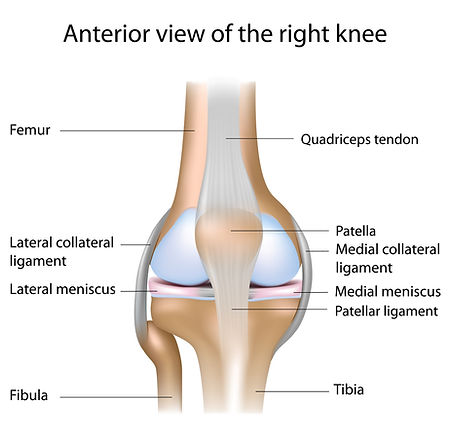
Knee Pain

The knee joint is a hinge joint with strong ligaments between the thigh and shin bones. Smooth cartilage covers the end of bones to reduce friction. There are also two extra pieces of thick cartilage called menisci which act as shock absorbers.
The knee ligaments and capsule (the bag that surrounds the joint), prevent the bones moving in the wrong direction or dislocating. The thigh muscles (quadriceps) also help to hold the knee joint in place and produce movement.
Problems with knee joints are common. See below for information on conditions / self help.
What is Knee Osteoarthritis?
Osteoarthritis (OA) is a common knee condition. The cartilage which protects the surface of your joints get worn/ damaged which causes friction and prevents the joint from moving smoothly.
The joint can become swollen and inflamed, the joint can change shape and the muscles can feel weaker.
Causes:
COMING SOON.
Symptoms:
Certain movements become difficult, especially trying to bend your knee.
Pain is usually into on the inside of the knee, but can be on the outside as well.
Your pain may get worse the more you walk or on weight-bearing activity such as stairs,
The knee feels stiff in the morning but gets a little better as you get moving.
It is more common in people over the age of 50
It may be triggered by an injury to the knee such as a fracture or come on for no particular reason.
Osteoarthritis can run in the family
A diagnosis is made by your clinical history and an x-ray to rule out other causes.
Treatment:
COMING SOON.
Exercises:
Versus Arthritis have also developed an exercise page where you can follow step by step exercises to help with your Knee Osteoarthritis.
Further Resources Versus Arthritis OA Knee Booklet https://www.versusarthritis.org/media/24020/osteoarthritis-of-the-knee-august2021.pdf
Alternatively, check out the https://escape-pain.org/i-have-knee-hip-pain/
Last reviewed Dec 2025. To be reviewed Dec 2026.
What is an Anterior Cruciate Ligament tear?
Causes:
COMING SOON.
Symptoms:
COMING SOON.
Treatment:
COMING SOON.
Exercises:
For more information on this, click here
The knee ligaments give the bones of the knee stability by helping to keep them together. There are two main sets if ligaments in your knee. The collaterals, which run down the sides of your knee and the cruciate ligaments, that are inside the knee.
Lateral Collateral Ligament (LCL):
The lateral collateral ligament is located on the outside of the knee .
What causes a LCL Injury?
The LCL can be damaged if your knee is forced inwards too much.
Medial Collateral Ligament (MCL):
The medial collateral ligament is on the inside of your knee.
What causes a MCL Injury ?
A MCL Injury of the knee is usually a result of a jumping or twisting injury or falling on a bent knee e.g a fall in skiing when been tackled .
Although a number of these injuries are not related to sport and can be from a sudden twisting of the knee or repeated trauma to the knee putting stress on the ligament which can change the elasticity of the ligament.
Symptoms of knee ligament injuries include:
Swelling around the knee
A Pop sound at time of injury
Pain
Instability (feeling of knee giving way)
Locking and catching of the knee
How to manage ligament injuries:
Protection: During the first few days after an injury, you should rest the injured joint. After 72 hours, gentle movement can be started. If walking is difficult or painful, a stick or crutch may help.
Although it might be painful, it is important to maintain movement in your knee to avoid stiffness. Complete non-weightbearing rest is rarely useful.
Ice: Applying ice with gentle compression using a bandage may help with pain relief and reducing swelling around your knee. Click here to download an information sheet
Elevation: Placing the knee higher than your hip whilst lying or sitting will help the swelling reduce.
Use of over the counter pain relief if necessary to enable to keep mobile. (Speak to your local Pharmacist if you are unsure about what you can take)
Exercise can help. Click here to download an exercise sheet.
If your knee does not start to improve within 2-3 weeks or you are concerned then seek further advice from a health professional. In some cases, following an in-depth examination, further investigation maybe necessary to decide on the best treatment plan.
Click below to download MCL exercise sheet
Level 1 - Early stage exercises for a MCL injury
Level 2 - Mid / Late stage exercises for a MCL injury
There are two menisci in each knee. They are shock absorbing cartliages and sit between your shin and thigh bone. One on the inside and one on the outside of your knee. Injury to your menicus can occur when you twist your knee when you have weight on it.
Symptoms :
Pain around the knee
Swelling
Clicking
Lack of knee movement
Locking (the joint becomes stuck in one position)
Giving way
In most cases, meniscal tears can be managed without surgery.
Things you can do to help yourself:
Protection: During the first few days after an injury, you should rest the injured joint. After 72 hours, gentle movement can be started. If walking is difficult or painful, a stick or crutch may help.
Although it might be painful, it is important to maintain movement in your knee to avoid stiffness. Complete non-weightbearing rest is rarely useful.
Ice: Applying ice with gentle compression using a bandage may help with pain relief and reducing swelling around your knee. Click here to download an information sheet
Elevation: Placing the knee higher than your hip whilst lying or sitting will help the swelling reduce.
Use of over the counter pain relief if necessary to enable to keep mobile. (Speak to your local Pharmacist if you are unsure about what you can take)
Exercise can help. Click the link to download an exercise sheet.
If your knee does not settle within 4-5 weeks or you are concerned then seek further advice from a health professional. In some cases, following an indepth examination, further investigation maybe necessary to decide on the best treatment plan.
Patella (Kneecap) dislocations are a common injury. The Patella usually moves within a grove (Trochlea) and sometimes it comes out of that grove causing the kneecap to dislocate this can also cause damage to the muscles and ligaments around the knee. Most commonly, the patella relocate its self but in some cases may need a health care professional to help.
What causes a Patella dislocation?
· Direct blow to the knee
· Sports injury
· Hypermobility
Symptoms
· Swelling
· Pain
· Stiffness when moving the knee
Treatment Firstly, the kneecap must be relocated; in some cases you might be given a brace to wear, this will only be for a short period. If symptoms do not improve and the kneecap continues to dislocate you may need to see an Orthopaedic specialist. Physiotherapy exercises are the best form of rehabilitation for kneecap dislocation and you should expect symptoms to improve in 6-12 weeks.
Click below for exercises
Level 1 - Early stages
Level 2 - Mid-Late stages
The Patellofemoral joint (PFJ) is the joint between the knee cap and the thigh bone. Problems with the PFJ can lead to pain anywhere around the knee.
Symptoms
Does not usually come on with trauma. More common after activity you have not done much of before....e.g walking, stairs or cycling.
Pain is usually to the front of the knee.
The pain may get worse the more you walk or go up or down stairs
It is more common in people over the age of 30
More common in overweight people.
A diagnosis is made by your clinical history. A scan would not normally show very much
The following can cause Patellofemoral pain:
Too much loading too quickly eg. Hill walking on holidays, or taking up new sports. Repetitive bending and kneeling can make it worse.
Anything that can affect the knee cap sliding correctly e.g flat feet, knocked knees etc
Injury e.g falls
Things you can do to improve your patellofemoral pain:
Exercise helps to keep the muscles strong so they will support the joint and help improve your symptoms. Click the link below
Stretching the muscles will also help. Keep thigh, calf and hamstrings muscles as flexible as possible (see below)
Avoid sustained activity/positions e.g sitting for long periods/ doing repetitive exercises as these can provoke the pain.
Stretching the Hamstrings.
Hold the stretch for 10-12 seconds and then release. You should feel a pull to the back of your leg when you stretch. Stop if the stretch is painful.
Stretching the Quadriceps.
Hold the stretch for 10-12 seconds and then release. You should feel a pull to the front of your leg when you stretch. Stop if the stretch is painful.
Stretching the calf muscles.
Hold the stretch for 10-12 seconds and then release. You should feel a pull to the of your lower leg when you stretch. Stop if the stretch is painful.
What is degenerative Meniscus?
Causes:
COMING SOON.
Symptoms:
COMING SOON.
Treatment:
COMING SOON.
Exercises:
Considering a knee replacment?



